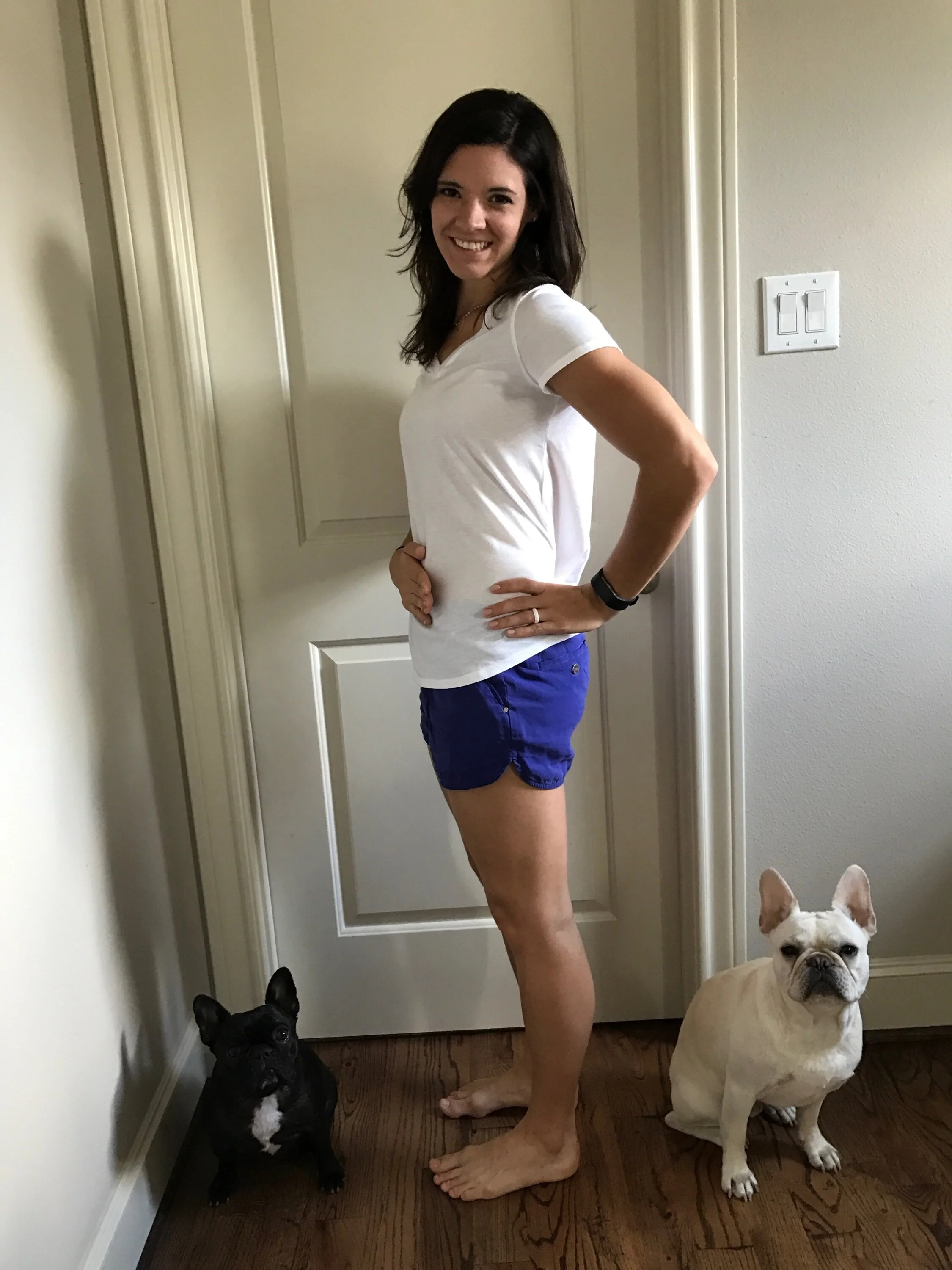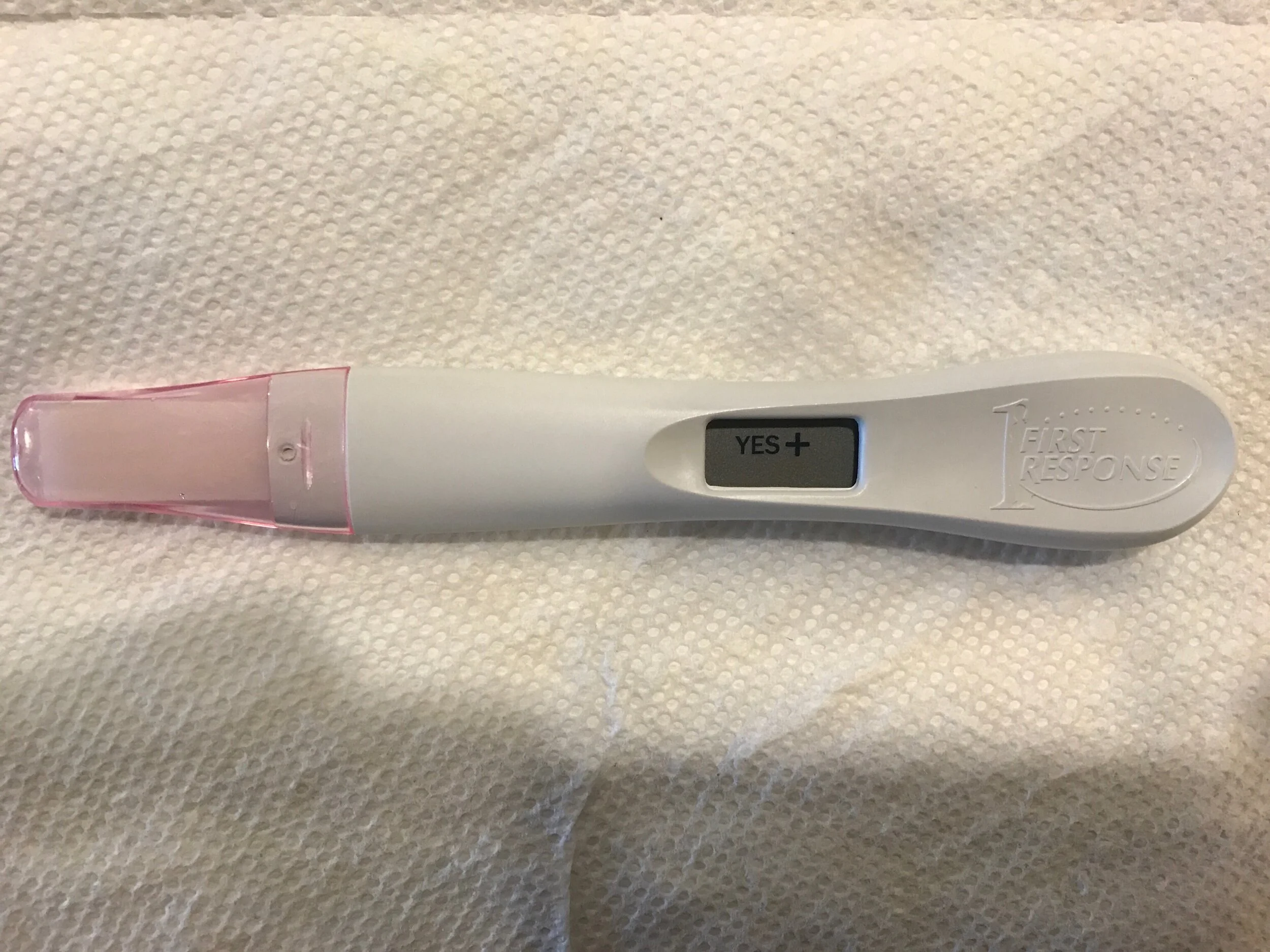Preparing to Conceive: Understanding My Body
When my husband and I conceived our first child, I was really really fit. Without the distraction of children and the responsibilities that come with them, I worked out for an hour or more daily. I was also dancing professionally, so I would go to class or rehearsal after those workouts. I coached Crossfit, and I taught dance in the evenings. During this time of my life I averaged like 14,000 steps a day and was on a fairly strict “paleo” diet. I looked and felt great.
Even though I really knew my body and how it could perform for me, there are things about the female body in general I just didn’t know, and thus wasn’t prepared for when I wanted my body to do something else (like make a baby).
Barely pregnant with our first daughter
The most obvious of these things was learning how to conceive. No no, this isn’t where I describe in detail some blush worthy positions to try or suggest that you lay with your hips propped up after intercourse... That’s an old wives tale by the way and you definitely don’t have to do those things to make a baby, regardless of what your weird aunt says. Rather, I remember being somewhat floored that conceiving really can only take place in a short window of time in a female’s cycle. Let me dial it back to eighth grade sex ed for a moment. I have a lot of opinions on “sex ed” but perhaps that is for a different blog post. Let’s just say I was beyond frustrated as an adult when I realized it was actually kind of hard to get pregnant after being convinced I would basically be knocked up if I even considered having unprotected sex, but I digress...
When a women’s cycle is not altered with a form of hormonal birth control, the body is in a constant state of preparing to get pregnant. The first day of the cycle is noted to be the first day of the menstrual period. The cycle lasts until the first day of the next day of bleeding, about a month later. It’s well known that the average cycle is 28 days, but do note the word average. It is completely normal for a cycle to be longer or shorter than 28 days. I personally have seen my own cycles this year that have lasted 29 days, and also cycles that have lasted 26 days. When the body is preparing to release an egg from an ovary, this is known as the follicular stage. When an ovary releases an egg, this is called ovulation and on average this occurs on day 14. Again note the word average. It’s important that you know how to read your body’s signs of ovulation, because it could be easy to miss and you may not be ovulating on day 14! My own cycle is a perfect example, I tend to ovulate between days 10 and 13. The days after ovulation until the start of the next period, known as the luteal phase, are the most consistent in the cycle. So where you may see variance in the number of days before ovulation (the follicular stage), you may not see as much variance in how many days after ovulation before you start menstruating again.
There are many ways to note and track your cycle, and signs and symptoms that your body presents to you like clues so that you can identify where within your cycle you are. If you’re a nerd like me, you’ll think this is absolutely fascinating. If you’re not, I’ll try to keep this short. I personally track my cycle using an app. There are a million available, and I think deciding which way to notate your cycle is somewhat determined by which symptoms you’re most likely to notice and notate.
For example, many women will take their basal body temperature to identify ovulation. Basal body temperature is a temperature reading taken directly upon waking up, before your feet even hit the floor (it needs to be a true resting temperature, so it is advised that you take it after four or more hours of sleep). This reading can pinpoint ovulation because ovulation shows an increase in basal body temperature. This does get a bit tricky however, because you’re the most fertile in the two or three days before ovulation, so I recommend not relying solely on basal body temperature to PREVENT pregnancy if you haven’t been tracking this symptom for a few months to somewhat identify your most consistent ovulation day. This could also be tricky if you wake frequently in the night (looking at you, breastfeeding mama).
Another symptom that clues you into your fertile window is cervical fluid. You may also hear this called cervical mucus, but I prefer fluid because it just sounds better. You may have noticed your cervical fluid before in your underwear, or perhaps when wiping after using the toilet. Your fluid will change over the course of your cycle, becoming more clear, stretchy, and lubricative (bow chicka bow wow!) during your most fertile days so that it can best aid sperm to get to your egg. After your period and before your fertile window you may notice no fluid, or fluid that is creamy, white, dry, or sticky. After the clear stretchy fertile egg white-like fluid in your fertile window, you may notice no fluid again or fluid that is dry and crumbly. Again, this may take a few cycles to get a grasp of.
Some women also choose to notate the position of their cervix, because believe it or not it moves throughout your cycle. When you are ovulating, your cervix moves up in your vaginal canal, opens, and softens. If you felt it with your finger it may feel soft like the tip of your nose, and you can identify the opening as a small dip. It reminds me of the opening in a tiny donut. In my experience, before the birth of my babies I could definitely identify a closed and an open cervix. But after two vaginal deliveries, my cervix kind of always feels open now… I’m not sure if this is medically accurate but I’m curious to know if any other mamas have observed this! I have found that the best place for me to check my cervix is sitting on the toilet. Another great place is the shower.
This is the app I use. I’m in no way affiliated with Ovia, but I do find the app easy to use.
Ok, so what should you track and how should you do it? I have done a lot of versions of tracking. Before we conceived Maggie I tracked all the things, using both an app and good ole pen and paper. I currently am just using an app, and I don’t bother with basal body temperature or cervical position. My cervical fluid is fairly obvious to me, but I have also been doing this for a few years now. My periods are also super regular. If you had irregular periods, or weren’t for sure what kind of fluid you are looking at, or have never felt your own cervix, maybe you start by tracking whatever you find the easiest to identify. There are many “methods” of fertility tracking as well, and also many teachers that can help you. I’ll link a few below in the Saint Louis area, as well as the app that I currently am using to track. It turns out that that Catholic Dioceses of Saint Louis has a great page with many area fertility tracking teachers and their schedule lined out, so I’ll include that below.
Some important things to consider about fertility tracking is that while some use this as a form of birth control, unprotected sex does come with a risk of pregnancy. So if you’re uncomfortable with that possibility and you’re actively preventing pregnancy then you need to avoid sex during your most fertile days or you need to discuss other methods with your partner to make sure sperm can’t get to an egg (cough cough, like a condom). Everyone forgets about condoms but they’re really not that bad! Another thing to think about is hormonal birth control and how it can affect fertility tracking. If you have been on hormonal birth control, like the pill, an iud, or a device in your arm like Nexplanon, this can alter your cycles for a few months even if you’re currently not taking or using these medications. My non-medical-professional suggestion would be to just keep charting and see if you can identify any markers and see when and if they become consistent. If you are currently using hormonal birth control, you will probably have some bleeding every month, but this is not a period and you won’t notice the other changes in your cervical fluid. The bleeding you see is known as “breakthrough bleeding” or “withdrawal bleeding” and is caused when your hormones are lowered in your birth control and thus also in your body, which causes your uterus to shed its lining.
If you have any questions about this, about your body and how it works or isn’t working, about birth control, GO ASK A MEDICAL PROFESSIONAL! I can’t stress this enough. If you think something is up, ask someone that can help you know. If you have abnormal cycles, ask someone about that. There are times and situations where simply learning your body and cycle is not enough to help you get pregnant, and that needs to be addressed. I’m just a fitness coach with a blog that’s really nerdy about the female body. I cannot answer questions about specific scenarios or offer any advice that isn’t anecdotal. But, I would be happy to connect you with some resources if you need them, and I also highly recommend the book “Taking Charge of Your Fertility: The definitive guide to natural birth control, pregnancy achievement, and reproductive health” by Toni Weschler. I used it for the entirety of this blog, and also it taught me how to conceive our babies!
Citation:
Weschler, T. (2015). Taking charge of your fertility: The definitive guide to natural birth control, pregnancy achievement, and reproductive health ; 20th Anniversary Edition. New York, NY: William Morrow, an imprint of HarperCollins.
Other Resources:
Drs. Michael Dixon and Brian Gosser, St. Gerard Obstetrics and Gynecology; St. Anthony’s Medical Center, 10004 Kennerly Road, Suite 386, in South St. Louis County; (314) 842-7910
https://www.facebook.com/MagnoliaFertilityCare
https://www.archstl.org/natural-family-planning/methods/introductory-sessions
The Ovia App
A positive pregnancy test circa 2017
I had no idea I would be using these images for a blog four years later!




